Gooferking Science
Hazard to Self
 
Posts: 97
Registered: 17-7-2013
Location: Somewhere in Kansas, USA...
Member Is Offline
Mood: Halogenated
|
|
Identifying Alkenes with Bromine Water
Hello Sciencemadness! Just FYI I am not an organic chemistry expert by ANY means. I am just sharing an interesting experiment. If I make any mistakes,
please tell me and I will change them.
Alkene molecules are organic molecules that have carbon - carbon double bonds in them. We will be using bromine water to differentiate alkane and
alkene molecules.
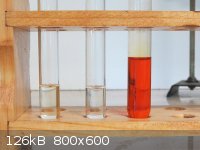
In the left test tube, I have an alkane molecule. In the middle test tube, I have an alkene molecule. In the right test tube I have a fairly
concentrated bromine water solution. To start, add some bromine water (With extreme care!) to the alkane molecule sample.
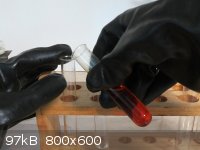 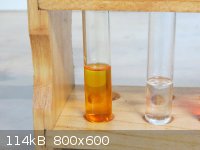
As you can see, the alkane molecule is immediately turned to an orange/yellow color from the dissolution of the bromine water. No reaction occurs.
Now add some bromine water to the alkene molecule sample.
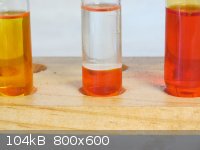
The two liquids don't immediately mix, and they form two layers. My guess is that they don't mix because one is liquid is polar and the other one is
non-polar. Since they aren't mixing on their own, stopper the test tube and shake it for a while to thoroughly mix the two liquids. During shaking you
will begin to see the dark orange/red color of the bromine fade away, till you are left with a cloudy white liquid, that should look like this:
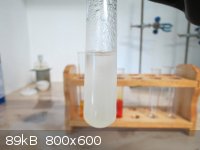
Now put the test tube back in your test tube rack and let it sit for a few minutes. The two layers will form again, but the bromine will have
disappeared from the water at the bottom.
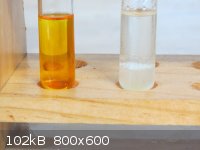
Here are the two test tubes side by side. Now let's discuss what has happened here. I will use ethene as an example to show what happened.
CH2=CH2 + Br2 (aq) --> Br-CH2-CH2-Br
As you can see, the bromine takes the place of the double bond, and in doing so it decolorizes itself. This is an example of an electrophilic addition
reaction.
I hope you have enjoyed this post! Unfortunately, it's time for a disclaimer.
Disclaimer:
This reaction MUST be performed outside in a respirator rated for bromine, or in a fume hood. You need to wear goggles and gloves, as well as cover
yourself with protective clothing. Use EXTREME care when handling bromine or any halogens for that matter. I am not responsible for injuries.
|
|
|
bfesser
Resident Wikipedian
    
Posts: 2114
Registered: 29-1-2008
Member Is Offline
Mood: No Mood
|
|
Nice work. I enjoyed the photos, particularly. Thanks for sharing.
P.S. Those gloves are a little overkill, in my opinion.
[edit] I'm a little surprised you didn't share the video:
<iframe sandbox width="420" height="315" src="//www.youtube-nocookie.com/embed/vBMGNzRYngk?rel=0" frameborder="0"
allowfullscreen></iframe>
What alkane and alkene did you use?
[Edited on 11.10.13 by bfesser]
|
|
|
Gooferking Science
Hazard to Self
 
Posts: 97
Registered: 17-7-2013
Location: Somewhere in Kansas, USA...
Member Is Offline
Mood: Halogenated
|
|
Thank you. I figure overkill is better than underkill  Yah I should have posted
my video, thanks for doing it for me. I used ethanol as my alkane, and turpentine (which is mainly pinene) as the alkene. Yah I should have posted
my video, thanks for doing it for me. I used ethanol as my alkane, and turpentine (which is mainly pinene) as the alkene.
[Edited on 11-10-2013 by Gooferking Science]
|
|
|
woelen
Super Administrator
        
Posts: 7977
Registered: 20-8-2005
Location: Netherlands
Member Is Offline
Mood: interested
|
|
Nice demo. The video also is quite nice. If I were you I would try to make a collection of such nice experiments and make write-ups for several of
them.
Just a remark. Using ethanol as alkane is not really good. Although it has no C=C bonds, it differs quite a lot from true alkanes. It has a C-OH group
(it is an alcohol) and this gives it specific properties, quite different from the properties of alkanes. One of the properties is that it makes the
compound soluble in water (especially for small chains).
A better substitute for ethanol would be ligroin or petrol ether (not to be confused with real ethers). Where I live, these are mixes of alkanes (and
possibly cycloalkanes) and do not mix with water. They only contain C-C bonds and no C=C bonds. Just look for the right product in your country, every
country has its own brands and names for this type of product. In NL we have so-called 'wasbenzine', which is a mix of (cyclo)alkanes, with boiling
points between 100 C and 140 C. Another common 'wasbenzine' is more volatile, with boiling range 40 C to 60 C.
Pinene is a decent example of an alkane. It has one C=C bond and a lot of C-C bonds and has cyclic structures, but the latter do not add unsaturated
behavior to the molecule. Another nice and easy to obtain standin for alkenes is dipentene (a.k.a. limonene), which has a lovely smell (oranges). Yet
another easy to obtain alkene is propene, but this is a gaseous one and the gas regulator to get this gas out of its cylinder is hard to find and
expensive in some countries, while it is cheap and easily available in other countries.
[Edited on 11-10-13 by woelen]
|
|
|
|